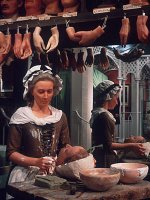Almost Lifelike

Marie Grosholtz, better known as Madame Tussaud, was born on this day in 1761 in Strasbourg, France. Her father died in the Seven Years' War when Marie was 2 months old, forcing her mother to take up residence in the home of physician and wax modeler Philippe Curtius as a housekeeper. Curtius' skill as a wax modeler became more celebrated than his medical skill, so he took it up as his profession, making lifelike wax portraits of famous people. In 1780 he moved to Paris with his student Marie in tow, and soon Marie became a well-known popular artist, attracting the attention of Louis XVI's sister Elisabeth, who invited her to live at Versailles, where Marie created wax figures of Louis, Marie Antoinette and the young prince who would come to be known as Louis XVII.
During the revolution, Marie made many death masks of some of the prominent people who were guillotined, and spent some time in the Bastille, sharing a cell with the future wife of Napoleon Bonaparte, Josephine Beauharnais. Narrowly escaping the guillotine herself, Marie frequented the Madeleine Cemetery, looking for the severed heads of more notables from which to make death masks.
In 1794, Curtius died and left Marie his exhibition. After marrying an engineer named Tussaud and having 3 children, Marie took her wax show to England in 1802, successfully traveling around the country with it and eventually settling near Baker Street in London in 1835. There she unveiled the "Chamber of Horrors" (originally called the "Separate Room," so as not to frighten the women guests), depicting scenes from the French revolution.
By the time Madame Tussaud died in 1850, Dickens would note that the Waxworks was "something more than an exhibition . . . an institution, with celebrities . . . strictly up to date . . . continuously added to every department of the exhibition"; there is little doubt that she was one of the earliest and most successful female entrepreneurs in Europe.
The Waxworks was damaged in a fire in 1925 and in the first night of the blitz in 1940 (although Hitler's figure remained unscathed), but numerous moulds were saved to permit recastings of some of the earlier figures. In 1990, over 2.5 million people visited the Waxworks in London.
Labels: Trailblazing Women





1 Comments:
Ron/Dad As you know, we lost our wax musiem . Some one bought it and it was taken to San Francisco. Mom and I got to go to it about two weeks before it closed and it was rea;y somthing. We will miss it.
Post a Comment
Subscribe to Post Comments [Atom]
<< Home